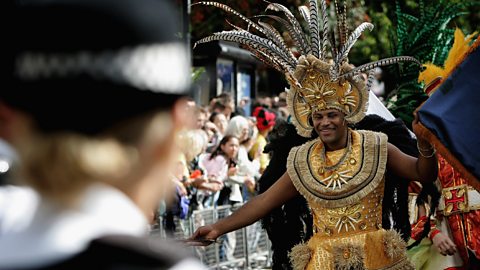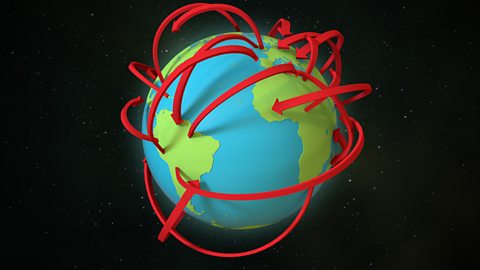Migration
Migration is the movement of people from one place to another for a short period of time or permanently.
This can happen internationally when people move from one country to another, or it can happen internally as people move within the same country.
There are many reasons why people migrate from one place to another. They might do so for financial, social or family reasons while some people are forced to move.
A person who makes a conscious choice to move somewhere else to live is known as a migrant or immigrant.
People who are forced to move are called refugees or asylum seekersSomeone who has been forced to move because of dangers in their own country, and is waiting while they apply for safety in another country..
Apart from births and deaths, migration is the only other factor that affects population growth and decline. It therefore plays an important part in the changes in a country's population over time.
Push and pull factors
The reasons for migrating can be broadly categorised as push and pull factors.
Pull factors are seen as positive things that attract people to a particular place.
Push factors are the negative things that make people want to move away.
Watch: Migration video
Watch this short clip to learn more about why people migrate.
What is a migrant? Put simply, a migrant can be defined as anyone who moves from one area to another - either voluntarily, or because they have no choice. A migrant doesn’t necessarily have to move halfway across the world. Someone can migrate internationally – or internally, within the same country. If you’ve ever moved from one place to another, congratulations! You’re a migrant! Take a balloon.
In Wales, there could be significant differences in identity within a single city or between parts of the same county. In Gwynedd, for example, you could be a “Bangor lad” or a “Cofi” from Caernarfon. Two completely different identities, a whole ten miles apart! You could associate yourself with the old industrial heartland of Blaenau Ffestiniog, or the tourist mecca of Abersoch, or the heights of Snowdonia.
Traditionally, people have been pulled towards the wealthier south-east, in search of increased job opportunities – often at the expense of the rest of the country. A migrant will often make their way from the country to the city, and then to the suburbs. There could be any number of reasons for someone to migrate, which can be broadly categorized into ‘push’ and ‘pull’ factors. ‘Push’ factors usually apply to the area the migrant is leaving. Conflict, high unemployment, poor public services… something that pushes people away. ‘Pull’ factors apply to the area the migrant is moving to. A higher standard of education, job opportunities… the weather, even. Something that pulls people in.
Both push and pull factors have had a significant effect on us in Wales. Throughout the 19th century, thousands of Italian immigrants felt themselves being pulled to Wales in search of work – mainly in the maritime industries. By the end of the century, something began appearing across Wales which was commonplace in Italy, but something that only those migrants could provide. Italian restaurants, cafés, and ice cream parlours. Just like that, and with a flake on the side, our culture was changed forever. Then came the Second World War. Terrified of spies, the British government began arresting every Italian that had not already taken British citizenship. After the war ended, there’s no doubt that this treatment will have pushed many Italian migrants away.
Nevertheless, by now, there are 40,000 people of Italian origin in Wales, The biggest Italian community in the UK. Migration has its drawbacks, of course. From pressure on public services to tension between migrants and the local population. But it can also bring great benefits. Migrants tend to be young – between 18 and 35 – which can revitalize areas of the country with ageing populations. And then there’s the staggering amount of money migrants pump into the economy each and every year.
With so many competing factors, it’s no wonder that the debate around migrants rages on. Whether they’re from Palermo, Poznań or Pwllheli.
Types of migration
There are many types of migration which are driven by different factors.
Internal migration
Internal migration is the movement of people within the same country, which can happen for several reasons.
Younger generations are likely to move to areas which provide better job opportunities, amenities and social lives. An example of this is younger people aged from 20-29 moving to cities such as London, Cardiff and Manchester.
Some people choose to move within the same country to be closer to other family members.
Economic migration
Economic migration is the movement of people for economic gain. People move to countries which can provide a better income.
After joining the European Union, many Eastern Europeans chose to migrate to countries such as France and the UK.
In North America, the much higher wages in the USA compared to its neighbour Mexico mean that many Mexicans move there in search of work.
Forced migration
Forced migration often occurs because of events such as a war which pose a sudden threat to people.
This happened in Syria when a civil war broke out in March 2011. By 2021, 6.6 million Syrians had fled their country. 5.5 million of these refugees found refuge in nearby countries like Turkey, Lebanon, Jordan, Iraq and Egypt.
Another 6.7 million Syrians had been forced to move inside Syria itself.
When people leave one country because of persecution or serious danger and ask for protection in another, it is called seeking asylum. People who are waiting for a decision on their claim are known as asylum seekers.
Climate change can also force people to move. Rising sea-levels will affect Bangladesh because half the country is less than 6 m above sea level.
The low-lying seaside village of Fairbourne in Gwynedd is also under threat. The increased danger caused by rising sea-levels and flooding means that flood defences will not be maintained in the future and the village will have to be abandoned.
Another example of forced migration is when thousands of Jewish people were forced to flee Germany in the 1930s because of increasing persecution and discrimination.
In 1938, nine months before the Second World War, the UK opened its borders to around 10,000 unaccompanied children between the ages of five and 17. They were mostly Jewish and were fleeing the Nazi regime. This process became known as Kindertransport.
In January 1933 there were about 523,00 Jews in Germany. By October 1941, when Jewish emigration was forbidden, there were only 163,00 left in the country.
Impacts of migration
Migration can bring advantages and disadvantages to the areas in which the migrants move to.
| Advantages | Disadvantages |
|---|---|
| A richer and more diverse culture | Increasing cost of services such as health care and education |
| Helps to reduce any labour shortages | Overcrowding |
| Migrants are more prepared to take on low- paid, low-skilled jobs | Disagreements between different religions and cultures |
Conflict caused by migration
Some areas of the UK have faced migration-related issues due to tension between migrants and local people.
1919 South Wales race riots
During the First World War there was a shortage of seamen in ports like Cardiff, Newport and Barry. People from all over the British Empire took the opportunity to come and work in south Wales.
After the war, there was a housing shortage and high unemployment. This led to many locals resenting the migrants living and working amongst them.
In Cardiff in June 1919 there were violent clashes in Butetown and around the docks. Large crowds attacked Arab lodgings and restaurants. Buildings were wrecked and some were burnt down. The riots lasted for three days, and three men were killed.
There were incidents in Barry and Newport too.
Notting Hill, 1958
Notting Hill in west London became a multicultural area due to the migration of people from the Caribbean after the Second World War.
It was a deprived area and there was competition for housing between poor black and white families. Some white people were openly hostile towards the newcomers.
In August 1958, mobs of mainly white youths attacked black people and their homes. The riots lasted a week as black people defended themselves.
The Notting Hill Carnival was established as a response to the riots. It is held annually and is led by the Caribbean community.


More on Change and movement
Find out more by working through a topic
- count2 of 3

- count3 of 3
